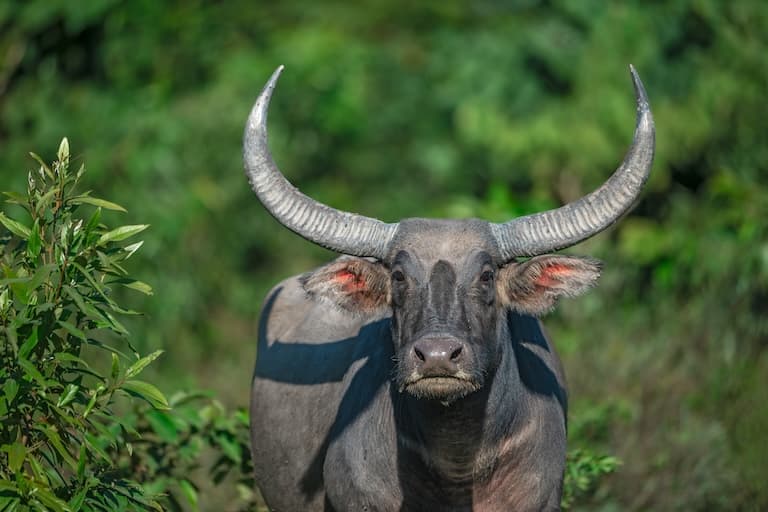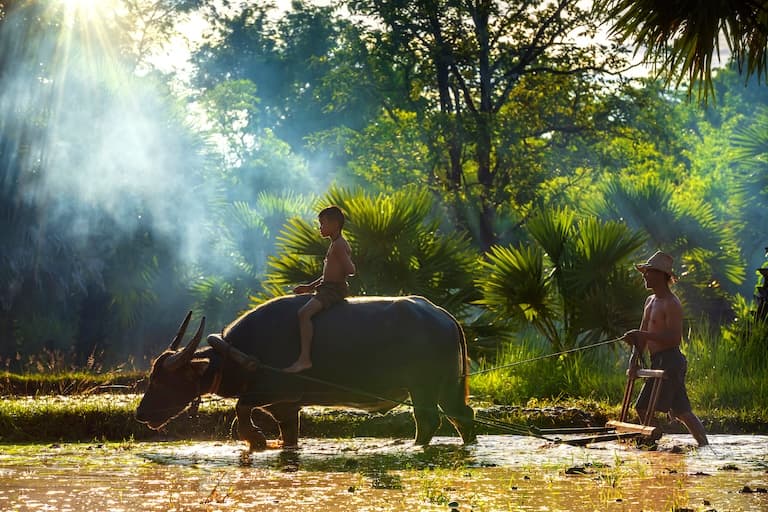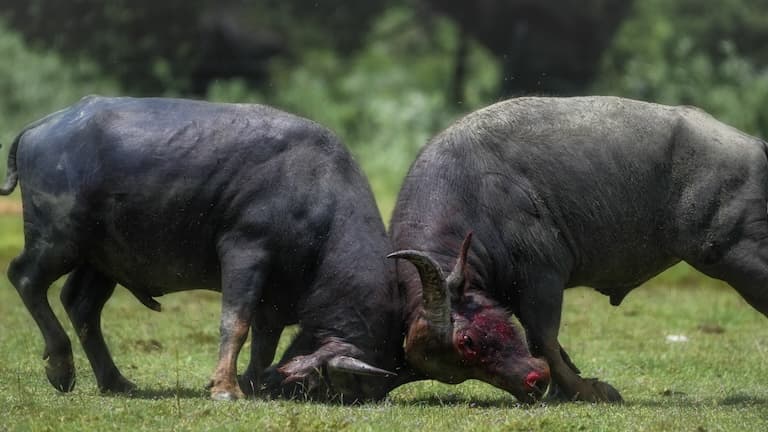Water Buffalo Profile
Buffalo are often misrepresented by Westerners. For one, their name is misused in both the US and Europe, and secondly, the African maniac buffalo – one of the most dangerous animals on the continent – gives all buffalo kind an unfair reputation for being highly strung and murderous.
Water buffalo, from Asia, are neither bison nor psychotic, and the wild variety is in a lot of trouble. And this is the ancestor of the domestic water buffalo, one of the hardest-working animals in human history.

Water Buffalo Facts Overview
| Habitat: | Wet areas, swamps and river basins |
| Location: | Southeast Asia, India. Introduced to Europe, Africa, Aus, the Americas. |
| Lifespan: | More than 40 years |
| Size: | Around 1.3m (52 inches) tall, up to 3m (118 inches) long. |
| Weight: | Domestic around 550 kg (1,200 lb) but up to 1200kg (2,600 lb) in Wild species. |
| Colour: | Grey to black |
| Diet: | Aquatic plants, grasses, fruits, herbs |
| Predators: | Tigers, crocodiles, dingoes |
| Top Speed: | 40 km/h (25 mph) |
| No. of Species: | 2 |
| Conservation Status: | Wild water buffalo is Endangered (IUCN) |
Water buffalo are actually buffalo; one of two genera of buffalo left in the world. There are two species, one likely the domestic descendant of the other, and the wild variety is in steep decline.
These large, mud-loving bovids are significantly less aggressive than their African namesakes, and spend a lot of time wallowing in holes full of water.
They’ve got special guts, even for a ruminant, and this allows them to eat things that grow in the water – a habit that comes in handy in areas with invasive plants.
Interesting Water Buffalo Facts
1. Miss Moniker
In North America, there’s quite a lot of confusion about what a buffalo is. The European wisent is also sometimes, but less frequently misnamed as a buffalo, but commonly, the North American bison is the leading cause of buffalo mismonikeration, which is not a real word.
Bison (and wisents) are not true buffalo, neither are they closely related to one. Buffalo exist in Africa and Asia and are represented by three main species: the African buffalo, the anoas, and the water buffalo.
From here, you might be able to separate water buffalo a couple more ways.

2. There are two types
The wild water buffalo, Bubalus arnee is a rare and enormous wild cow and the ancestor of the domestic water buffalo. They are now endangered, but once spanned much of the continent. They are larger and heavier than their domesticated relatives, also called water buffalo, and likely separated by only around 6500 years.
The water buffalo looks quite similar to the wild water buffalo, but there are two types: the river buffalo and the swamp buffalo.
River buffalo are found primarily in India, but also now in Egypt and Italy. Swamp buffalo remain around Southeast Asia and as far East as the Yangtze.
Interestingly, these two types have different numbers of chromosomes, with the swamp buffalo offering up 48 to the river buffalo’s 50.

3. Some are feral
There are some populations of water buffalo in Sri Lanka, and these large, horny beasts bring tourists in to look at them, but it’s unlikely that these are true wild water buffalo. It’s thought that populations in Sri Lanka and many elsewhere, descend from feral ancestry of the domesticated water buffalo.
Regardless, they are a sight to behold and fit right into their wet environments, and can be quite a healthy addition into areas where the natural fauna has gone extinct.
4. They’re muddy
Buffaloes love the water. And water buffaloes would be doing their name a disservice if they didn’t spend almost all their lives in it.
The swamps and rivers these cows inhabit help keep them cool, away from predators and provide them food in the form of aquatic plants.
They’re not as good at sweating as other cows, so this thermoregulation is important, and one way to mimic the effects of sweating is to cover oneself in thick, wet mud, and let it evaporate over time. 1
5. They’re horny
River and swamp buffaloes can be told apart by the arrangement of their horns. Swamp buffalo horns grow out and then curve in a semicircle back again. They’re usually in line with the plane of the forehead.
In contrast, the river buffalo grows horns that move downward and backwards before they curve back. This is a general rule, and there’s quite a lot of variety within both groups, but in general, they can usually be told apart in this way.
River buffalo, as the name suggests, prefer deeper water, which is one of the other ways to tell them apart. But in both types, the males are impressively promiscuous. In a good year, a male water buffalo can impregnate 100 females, as long as he doesn’t overheat.

6. They have unusual guts
Even for a ruminant, the water buffalo gut is a little unusual. Compared with others, it has a lot more bacteria, especially those bacteria that break down cellulose. It also contains a higher number of zoospores, which are kind of like microbe sperm, swimming about as reproductive states of a larger organism.
Their strange microflora ratios appear to result in lower methane production and work better at degrading plant fibres. 2
7. They can be good conservationists
All this efficiency makes water buffalo good eaters. And in areas where aquatic herbivores have all but died out, they can be brought in to control invasive or explosive weed problems in waterways.
Introduced buffalo graze on the out-of-control plants and help protect and rebalance the ecosystem. That is if they’re properly managed.
A herd of these cows can do all kinds of damage to vegetation, bird nets and reptile breeding areas if their introduction isn’t handled properly. 3
Water Buffalo Fact-File Summary
Scientific Classification
| Kingdom: | Animalia |
| Phylum: | Chordata |
| Class: | Mammalia |
| Order: | Artiodactyla |
| Family: | Bovidae |
| Genus: | Bubalus |
| Species: | B.bubalis; B. arnee |
Fact Sources & References
- “Wild Water Buffalo”, IUCN Red List.
- Nat Commun (2022), “The microbiome of the buffalo digestive tract”, PubMed Central.
- “Bubalus bubalis water buffalo”, Animal Diversity Web.
